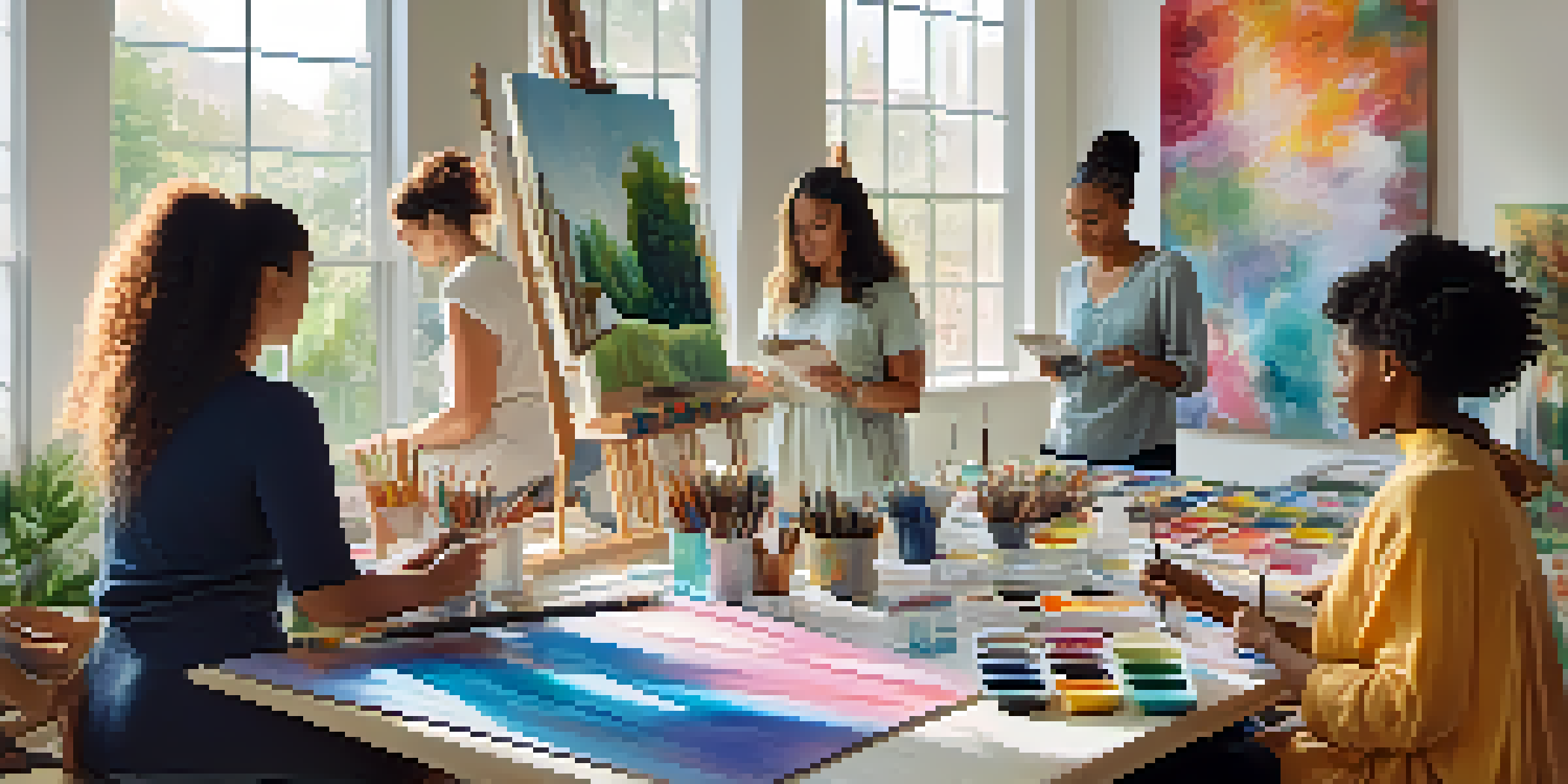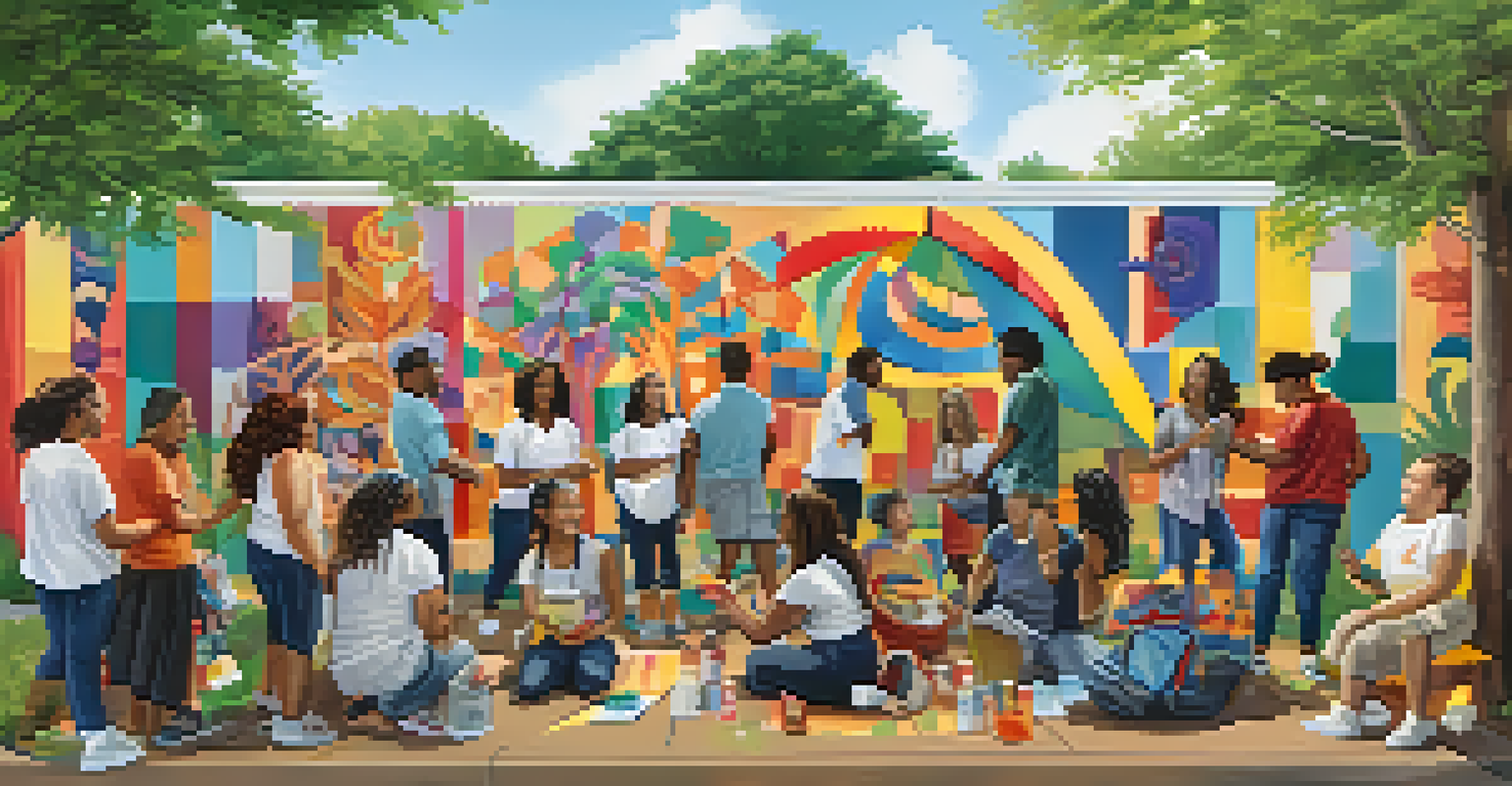Art Therapy and Its Role in Healing Trauma from Injustice

Understanding Art Therapy and Its Benefits
Art therapy is a unique therapeutic approach that combines the creative process of making art with psychological healing. It offers individuals a safe space to express emotions that might be hard to articulate in words. This form of therapy can be especially beneficial for those dealing with trauma, as it allows for exploration of feelings in a non-verbal manner.
Art enables us to find ourselves and lose ourselves at the same time.
By engaging in artistic activities, clients can tap into their subconscious, uncovering feelings related to their experiences of injustice. This process can lead to greater self-awareness and understanding of their emotional landscape. Moreover, creating art can be a comforting and empowering experience, offering a sense of control in the face of trauma.
The benefits of art therapy extend beyond mere expression; they also include stress relief and enhanced coping skills. Participants often find that engaging in creative activities can provide a much-needed break from their distressing thoughts, allowing for moments of joy and relaxation. Ultimately, art therapy fosters resilience, helping individuals navigate their healing journey.
The Impact of Trauma from Injustice
Trauma resulting from injustice can take many forms, including systemic discrimination, violence, and social alienation. Individuals who experience such trauma often face deep emotional scars that can disrupt their daily lives. Understanding the psychological impact of injustice is crucial in recognizing how it affects mental health and overall well-being.

Victims of injustice may struggle with feelings of anger, helplessness, or anxiety, which can lead to withdrawal from social interactions or self-destructive behaviors. This emotional turmoil can manifest in various ways, making it essential to address these feelings in a supportive environment. Recognizing the effects of injustice is the first step toward healing and recovery.
Art Therapy Aids Emotional Healing
Art therapy allows individuals to express difficult emotions non-verbally, promoting healing and self-awareness.
Art therapy provides a pathway for individuals to process these heavy emotions. By translating their experiences into art, they can confront their trauma while simultaneously working towards healing. This creative outlet allows for a unique form of storytelling, helping them reclaim their narrative and foster a sense of empowerment.
How Art Therapy Facilitates Emotional Expression
One of the most powerful aspects of art therapy is its ability to facilitate emotional expression. Many individuals find it challenging to articulate their feelings verbally, particularly when it comes to deeply rooted trauma. Art therapy offers a different avenue, allowing them to communicate through colors, shapes, and forms.
Creativity takes courage.
For instance, someone who has faced injustice might channel their anger into bold strokes of paint or create a collage that reflects their experiences. This process can be liberating, leading to an emotional release that verbal communication may not provide. As clients engage in creating, they often experience a sense of relief and clarity that can aid in their healing journey.
Furthermore, the act of creating art can instill a sense of agency and control, which is particularly important for those who have felt powerless due to injustice. By making choices about their artistic expression, clients can reclaim a sense of power over their narrative. This empowerment is a crucial step in overcoming the emotional weight of trauma.
Building a Safe Space in Art Therapy
Creating a safe and supportive environment is fundamental to the success of art therapy. Clients must feel comfortable expressing their feelings without fear of judgment or misunderstanding. Therapists play a vital role in establishing this safe space, helping individuals feel secure enough to explore their emotions and experiences.
In a supportive setting, clients can take creative risks, knowing that their feelings are valid and respected. This trust fosters an open dialogue about their trauma and allows deeper exploration of their emotional landscape. The therapeutic relationship built between the client and therapist is essential for effective healing.
Trauma from Injustice Requires Support
Experiencing injustice can lead to deep emotional scars that necessitate supportive environments for healing.
Moreover, this safe space extends to the materials and methods used in art therapy. Clients can choose the mediums with which they feel most comfortable, whether it be painting, drawing, or sculpting. This autonomy in choice not only encourages self-expression but also reinforces the idea that their story is theirs to tell.
Case Studies: Success Stories in Art Therapy
Numerous case studies highlight the transformative power of art therapy in addressing trauma from injustice. For example, a group of survivors from a community affected by violence participated in a collaborative mural project. Through the process, they shared their stories and emotions, ultimately creating a piece of art that represented their resilience and hope.
Another case involved an individual who experienced systemic discrimination, leading to feelings of isolation and despair. Through art therapy, they created a series of self-portraits that reflected their inner struggles and aspirations. This visual exploration not only facilitated healing but also helped them reclaim their identity beyond their experiences of injustice.
These success stories illustrate that art therapy can be a powerful tool for healing. By providing a creative outlet, it empowers individuals to confront their trauma, share their stories, and find community support. The impact of these experiences can be profound, often leading to lasting change in their lives.
Integrating Art Therapy into Holistic Healing
Art therapy is most effective when integrated into a holistic approach to healing. This means combining it with other therapeutic modalities, such as talk therapy or mindfulness practices. By addressing trauma from multiple angles, individuals can gain a more comprehensive understanding of their emotional health.
For instance, a client may engage in traditional talk therapy to discuss their experiences while using art therapy to process their feelings visually. This combination can create a richer therapeutic experience, allowing for deeper insights and healing. It also provides clients with a variety of tools to cope with their trauma.
Integrating Therapies Enhances Recovery
Combining art therapy with other therapeutic methods provides a comprehensive approach to understanding and coping with trauma.
Integrating art therapy into a larger healing journey encourages a more personalized approach. Each individual’s experience with trauma is unique, and their healing process should reflect that. By offering various therapeutic options, clients can choose what resonates with them most, fostering a sense of ownership over their healing journey.
The Future of Art Therapy in Addressing Injustice
As society continues to grapple with issues of injustice, the role of art therapy is becoming increasingly vital. There is a growing recognition of the importance of mental health support for marginalized communities. Art therapy can serve as a powerful tool for those seeking to heal from the scars of injustice, providing a means of expression and empowerment.
Future developments in art therapy may include more community-based initiatives that focus on collective healing. By bringing individuals together through shared artistic experiences, communities can foster solidarity and resilience. This collaborative approach not only addresses individual trauma but also strengthens community bonds.

Additionally, as awareness of art therapy expands, more educational programs and resources will become available. This will empower therapists and clients alike to harness the transformative potential of creativity in healing. With continued advocacy and research, art therapy can play a significant role in the journey toward healing from trauma caused by injustice.